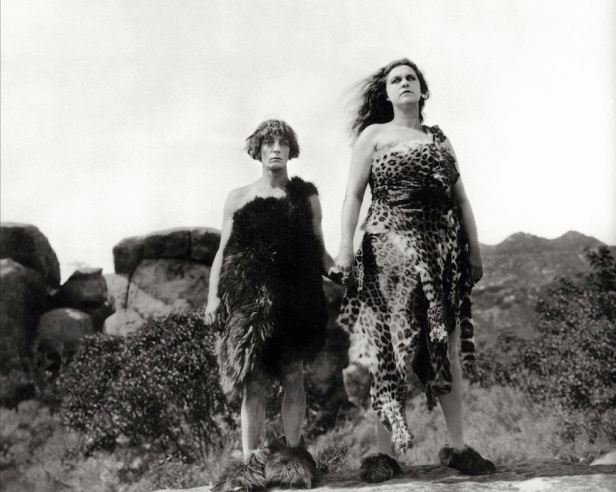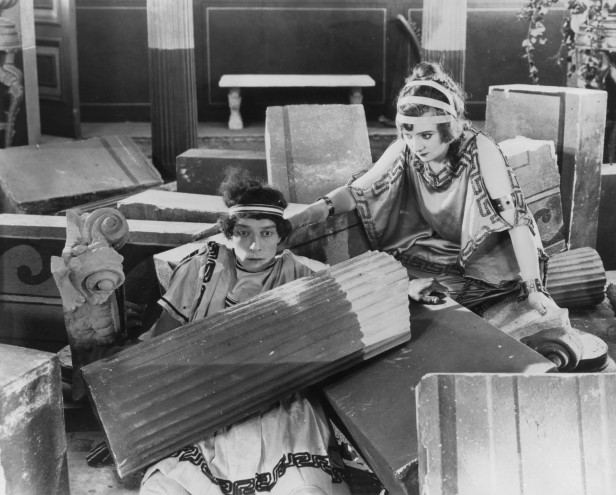
“If you let your mind wander back through History you will find that the only thing that has not changed since the World began is — LOVE. Love is the unchanging axis on which the World revolves,” a preface page reads in the opening scene of Buster Keaton’s Three Ages (1923).
This opening sets up the film’s general premise of portraying how love has not changed much through history. Constructed as three alternating episodes set in the stone age, ancient Rome and the 1920s, the film has Buster Keaton starring in each section as a suitor who must battle another man (Wallace Beery) to win over the apple of his eye (Margaret Leahy). He must also contend with the lady’s overprotective parents in each segment. Some things never change, even as hundreds of years pass!
Three Ages was the first feature-length film that Keaton wrote, directed produced and starred in. According to IMDb’s trivia on the film, Keaton chose the episodic format so the film could be cut into three shorts and re-released if it was unsuccessful as a feature, since he was already greatly successful in short films. Fortunately, that didn’t happen. The film was a success and Buster continued to make feature-length films, further cementing himself as the legendary talent that he is still remembered as today.

With every Buster Keaton film I watch, I fall a little bit more in love with him. He was a fantastic performer, a fantastic writer, a fantastic director. His films are always so much fun to watch, both for their entertainment value and for appreciation of his skill as a filmmaker.
Three Ages is a film that brings a whole lot of laughs. Sometimes the laughs are from comical special effects, such as Buster riding on a huge dinosaur during the stone age portion of the film.
Sometimes the laughs come from the title cards, which often contain rhyme and wit. “I want to ask Wee-gee if she loves only me,” a title card states during the stone age, as Buster is visiting a cave-dwelling fortune teller.
Sometimes the laughs come from the stereotypical portrayals of the people of each time period — the Flinstones-esque wardrobe and club-carrying of the stone age sequences, a tense chariot race in the Roman sequence.
And of course, many of the laughs come from Buster’s use of physical comedy and expression. One infamous scene has Buster jumping from one roof to another and falling short. This was a real miss made by Buster, who did his own stunt work and was not intending to miss. He was injured pretty badly and ordered to rest for three days, but he loved how the fall looked so much that he decided to keep it in the film, adding in extra shots in which he falls through awnings on his way to the ground. Physical comedy can be dangerous work, but it looks absolutely brilliant on screen and the knowledge that Buster was injured during the making of this film gives me an even greater appreciation for his dedication to his work.
All of this adds up to a film that is so incredibly fun to watch. The fast-paced, episodic structure of the film keeps the viewer on their toes, though Buster needs no help keeping the audience engrossed in the stories he is telling. Three Ages is a wonderful watch. The score: 5/5!

Quite a few Busters available on Netflix Streaming…I just watched ‘Seven Chances’, which was great, and I’ll be checking out ‘The General’ soon. I’ve seen it before, and loved it, and highly recommend it if it’s one you haven’t seen yet. And yes, I’ll add ‘Three Ages’ to my queue if it’s available!
LikeLike
Seven Chances was one of the first films I reviewed this year. Love that one! Love ‘The General’ as well — I’m forever kicking myself for missing the chance to see it with live accompaniment a few months ago.
They’ve also got an interesting collection of Chaplin shorts I’m excited to watch on Instant. Their selection of silents isn’t huge, but it has some good stuff!
LikeLike
Did I completely miss your review for ‘Seven Chances’? Wait, I may not have been following your site at that time…I’ll go to your archives and check it out…AFTER I write my own review, so I won’t be subconsciously influenced by your comments!
And I remember you mentioning the possibility of seeing ‘The General’ at that old-time theater of yours…the Redford, right? That would’ve been pretty cool.
Good lord, Lindsey, I just visited their site…do you know about their upcoming slate of screenings? I may just fly out to Michigan and live there for a few months: Notorious, Jaws, Shirley Jones in-person for The Music Man, and a VINCENT PRICE film festival!
LikeLike
You didn’t miss that review — I just looked and you commented saying you were adding the film to your instant queue, haha. :) I post so frequently, though, that I can barely remember what I’ve reviewed. It comes as no surprise that I’m not the only person who can’t keep the jumble of film titles straight!
The General was at another local venue called The Senate Theater. Both are fantastic places to watch classics on the big screen, though the Redford is fancier. Notorious is right before my birthday so I’ll definitely be needing to make the trip out to the Redford for that! Might go for The Long, Long Trailer too — that film is a complete riot. I’m also going to try to make it to the third day of the Vincent Price festival to see The Tingler, though that will be more difficult to make since I’ll be back in school again. The metro Detroit area is a great place to be a classic film fan.
LikeLike
My request: if you can, write up an article about your trip to the Redford, whether it be for Notorious, The Tingler, or The Long, Long Trailer. I really liked that last one you did…I believe it was for Rope.
Glad I checked out your Seven Chances review, and embarrassed I didn’t remember doing so! Derf!
LikeLike
I definitely will do a write-up on my next trip to the Redford! I’m 99% sure I’ll be going for Notorious. Since that screening comes at about the same time as the William Castle blogathon I’m participating in, the Notorious post won’t be able to go up immediately, but you can expect it in early August.
LikeLike
I, as always, will be there! Maybe I’ll put a Notorious review up, too…it’s been a while since I’ve watched it.
And now that I think about it…we had talked about a movie recently that we were both thinking about reviewing and posting at the same time, and of course, now I can’t remember which movie it was! I’ll do a little backtracking of comments and try to figure it out…was it The Crawling Eye?
LikeLike
Just waded through some old comments — it was Invasion of the Star Creatures. My review of The Crawling Eye went up on June 5, so I knew it couldn’t have been that!
LikeLike
Okay, Invasion of the Star Creatures…coming soon to The Derby Killer! I’ll keep you posted!
LikeLike
Alright! Just email me or leave a comment a few days ahead of time so I can make sure I don’t have a conflict with any of the 3471987893 blogathons I’ve signed myself up for this summer, haha.
LikeLike
Ha! I was going to do ONE blogathon, my first ever, over at Movies, Silently…but I didn’t have enough time!
I was going ask, again, how you find the time…but I keep forgetting about your 4,000 employees working on your blog site 24/7! ;)
LikeLike